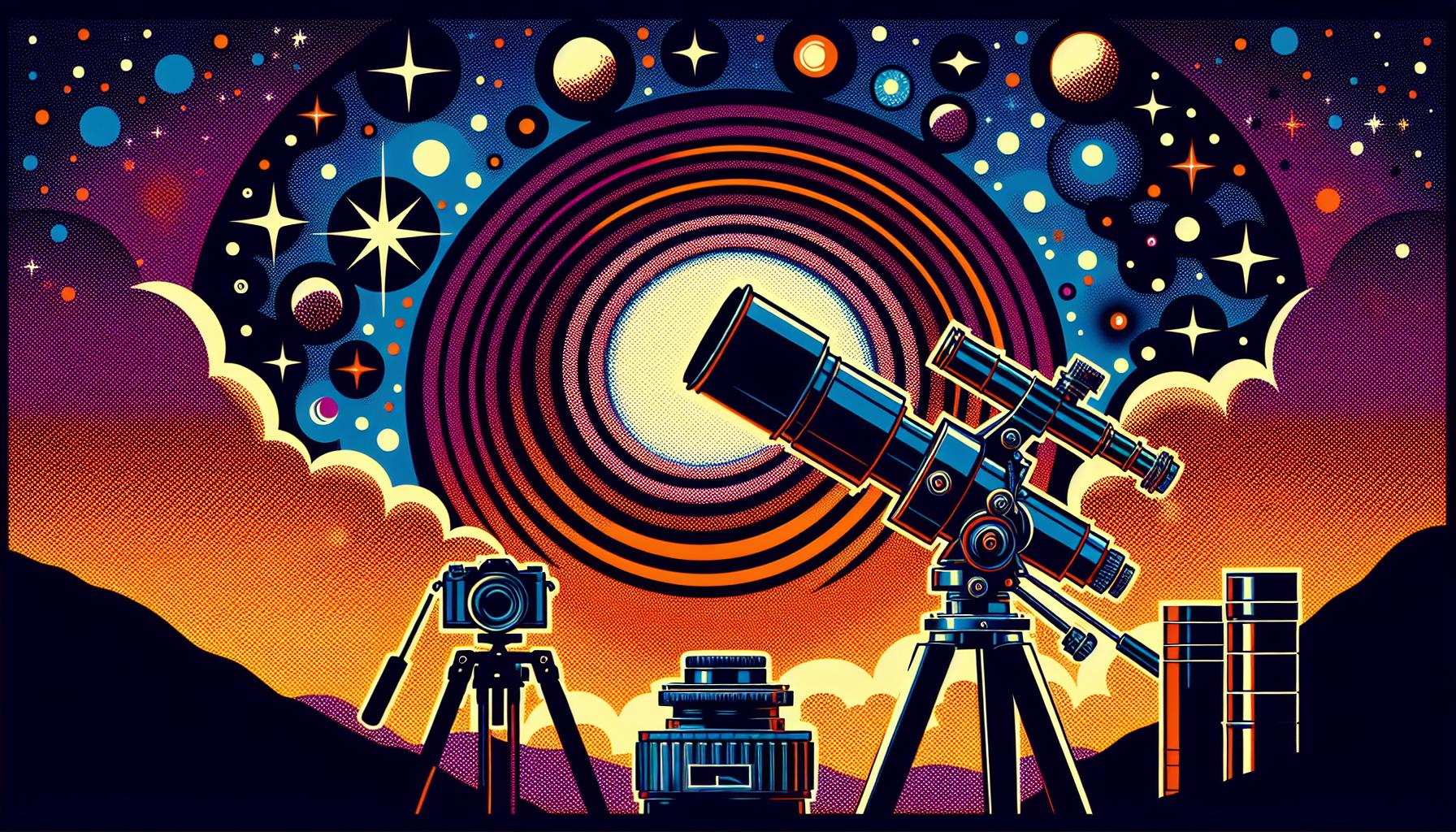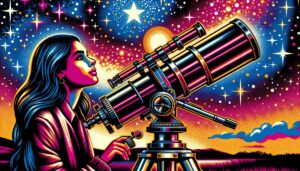This site contains affiliate links to products. I may receive a commission for purchases made through these links.
If you’re like me, you’ve probably spent countless nights gazing up at the stars, wishing you could capture their beauty. That’s where a Dobsonian telescope for cameras comes in. It’s a game-changer for amateur astronomers and photography enthusiasts alike.
Dobsonian telescopes, named after their creator John Dobson, offer a simple yet effective design. They’re known for their large aperture sizes and ease of use, making them perfect for deep-sky viewing. When paired with a camera, the possibilities are endless. You’ll be able to capture stunning images of galaxies, nebulae, and star clusters.
So, if you’re ready to take your star-gazing to the next level, stick around. I’ll be diving deep into the world of Dobsonian telescopes for cameras, sharing everything you need to know to get started. From choosing the right model to mastering the art of astrophotography, I’ve got you covered.
What is a Dobsonian Telescope?
One may ask, “What’s a Dobsonian Telescope?” Quite simply, it’s named after its creator, John Dobson, a well-known amateur astronomer. What makes this telescope unique is its design. The Dobsonian style is a variation of the Newtonian style telescope – a type of reflecting telescope invented by astronomer Isaac Newton.
The Dobsonian telescope isn’t your typical astronomer’s tool. It’s characterized by a simple yet effective mount, making it highly maneuverable. The design focuses on two things: ease of use and large aperture size.
Ease of use is one of the significant advantages of a Dobsonian design. Its ‘alt-azimuth’ mount, akin to a lazy Susan, allows for simple left-right and up-down movements. This intuitive design means that even a novice can easily navigate the night sky.
When it comes to aperture size, Dobsonians take the cake. Large aperture size permits more light to come into the telescope, enabling the viewing of more distant and faint celestial bodies. Capable of offering a wide range of aperture sizes, Dobsonian telescopes are popular for deep-sky viewing.
For the astrophotographers among us, with the right that kind of camera, you’ll find few better tools than a Dobsonian. When equipped with a camera adapter, these telescopes become a powerful tool for capturing breathtaking images of galaxies, nebulae, and star clusters.
Understanding the above features and functionalities will not only help you maneuver the Dobsonian telescope effectively, but it’ll offer an enriched stargazing experience. However, as we venture further, remember that using a Dobsonian telescope for photography involves more than just attaching a camera.
Advantages of Using a Dobsonian Telescope for Cameras
When it comes to astrophotography, nothing quite compares to the experience of using a Dobsonian telescope. Its simplistic design combined with large aperture sizes offers unparalleled advantages. Paried with the right camera, it becomes an instrument capable of capturing the universe’s splendid beauty.
The first noteworthy advantage is the larger aperture size that Dobsonian telescopes are known for. As any astronomy enthusiast will tell you, when it comes to observing celestial objects, aperture is king. A larger aperture allows for more light to be captured, which means brighter, clearer images. This is especially handy when you’re trying to get detailed shots of galaxies, nebulae, or star clusters.
Dobsonian telescopes are also celebrated for their ease of use. The design is simple, with no complicated setups or adjustments required. This is a serious advantage for astrophotography beginners who may be intimidated by more complex telescopes. The simplicity allows you to focus on the skies rather than on setting up your equipment correctly.
It’s also worth mentioning that Dobsonian telescopes provide superb value for money. Compared to other telescope types with a similar aperture size, Dobsonians tend to be more affordable. This makes them the ideal choice for astrophotographers who are budget-conscious but still desire exceptional results.
Below is a brief table that lists some key features that make Dobsonian telescopes ideal for astrophotography:
| Feature | Benefit |
|---|---|
| Large aperture size | Brighter, clearer images. |
| Ease of use | Simple setup and adjustment, ideal for beginners |
| Value for money | High-performing and affordable compared to similar scopes |
So, whether you’re a seasoned astrophotographer or a budding stargazer, a Dobsonian telescope paired with a capable camera can serve as an exceptional tool to help capture the night sky’s awe-inspiring beauty.
Remember, enjoying astrophotography starts with the right equipment. Don’t undersell the importance of investing in a quality telescope and a reliable camera that best suits your needs.
Choosing the Right Dobsonian Telescope for Photography
When it comes to astrophotography, not all Dobsonian telescopes are created equal. There are a few key factors to consider that can significantly affect your photography experience. It’s not just about the aperture size, but choosing the right Dobsonian telescope for photography necessitates the understanding of several features.
Firstly, consider the focal ratio, oftentimes referred to as the ‘f/number’. The lower the f/number, the wider the field of view. This can greatly enhance your ability to capture larger celestial objects like nebulae and galaxies. Be reminded though that a lower focal ratio may also lead to distortions.
Another key feature to assess is the mount. Dobsonian telescopes are known for their Alt-Azimuth mounts which are simple to use but can pose challenges for long-exposure photography. Equatorial mounts, though more complex, allow for smoother tracking of celestial bodies making it an upgrade worth considering.
Lastly, think about the telescope’s compatibility with your camera. Confirming the mounting type and whether an adapter is needed can save you frustration later on. Let’s not forget to evaluate the focusing capabilities, ensuring your Dobsonian telescope can bring the stars to sharp, crisp focus should be a priority.
Keep in mind that while Dobsonian telescopes provide great value for money, the accompanying camera should also ideally be high quality to take full advantage of the telescope’s capabilities. A decent DSLR or Mirrorless camera with a wide dynamic range can complement the Dobsonian telescope well.
It’s important to note that jumping straight into astrophotography can feel overwhelming due to the intricacies of the equipment and techniques involved. But don’t let this discourage you! Start small, grow your knowledge base, and upgrade your equipment as you become more proficient and ambitious in your celestial quest.
Remember, each step brings you closer to capturing those breathtaking images of our cosmos that make the journey so worthwhile. And with the right Dobsonian telescope at your side, there’s no limit to what you can achieve.
Essential Accessories for Dobsonian Astrophotography
Having covered the primary factors to consider when choosing a Dobsonian telescope, let’s now delve into the essential accessories for your astrophotography pursuits. After all, astrophotography isn’t just about the telescope or the camera. There are important accessories needed to enhance the capability of these prime tools.
No doubt, high-quality cameras are paramount. In fact, they’re one key component that can make or break your stargazing experience. But what other items should you be zeroing in on? Let me help you with that.
A must-have) accessory is a stable mount. Dobsonian telescopes are renowned for their solid mounts, but an additional astrophotography-specific mount can prove highly beneficial. The trick lies in choosing a mount that complements your telescope’s and camera’s abilities – balancing their weight and ensuring smooth tracking.
Next in line is an Equatorial Platform. This quirky accessory might seem puzzling to beginners, but it’s a game changer in the world of astrophotography. An equatorial platform aids in tracking celestial bodies. This enhancement of your Dobsonian telescope’s tracking capacity allows for better, longer exposure times – crucial for capturing high definition, detailed images of far-flung celestial objects.
Of course, we cannot forget the T-Adapter and T-Ring. The dynamic duo! These not-so-famous heroes marry your camera to your telescope. They’re essential for prime focus photography – in short, they’re the bridge you’ll need to fit your camera onto your telescope.
Lastly, Filters are another accent to your astrophotography kit. They reduce light pollution, a problem prevalent in urban settings. Lunar and solar filters are always handy, allowing you to capture explicit, sharp images of moons and suns, both near and far.
Tips and Techniques for Astrophotography with a Dobsonian Telescope
As someone who’s spent years exploring the stars, I can’t emphasize enough the importance of knowing the right techniques for astrophotography with a Dobsonian telescope. This is more than just understanding your device; it includes taking into account several other factors that could significantly enhance the quality of your images.
Firstly, aligning your telescope is a skill you need to master. This procedure is crucial as it helps track celestial objects with greater accuracy. With a Dobsonian, I often align it with the North Star, Polaris, since it barely moves in the sky.
Another technique that I swear by is long exposure photography. With a Dobsonian telescope, you could take images of the sky with exposures lasting several minutes. This offers a chance to photograph faint galaxies and nebulae that aren’t visible to the naked eye. However, keep in mind that such long exposures need a tracking mount or an equatorial platform mentioned previously in this article.
Here’s another tip – don’t underestimate the power of stacking images. Stacking multiple images will help increase the signal-to-noise ratio, providing a clearer picture of the objects you are trying to capture.
Let’s consider a typical setup:
| Accessory | Use |
|---|---|
| Dobsonian Telescope | Primary equipment for viewing and capturing celestial objects |
| Tracking Mount/Equatorial Platform | For accurate tracking and long exposure photography |
| T-Adapter and T-Ring | To connect the camera to the telescope |
| Filters | To reduce light pollution for clearer images |
Even though I’ve provided some insights, the secret of astrophotography lies in practicing and experimenting. Even after using the right equipment and following these tips, it’s your patience and perseverance that will bring you the best shots. So keep observing, keep photographing and soon you’ll be mastering the art of capturing the universe with your Dobsonian telescope.
Conclusion
So there you have it. Mastering astrophotography with a Dobsonian telescope isn’t a walk in the park. But with the right equipment – a sturdy telescope, a tracking mount or equatorial platform, a T-Adapter and T-Ring, and the right filters – it’s achievable. The key is aligning your telescope properly, preferably with the North Star, and using long exposure techniques to capture those elusive galaxies and nebulae. Remember, stacking multiple images can significantly improve your results. But above all, practice and experimentation are your best teachers. So don’t be afraid to try, fail, learn, and try again. With time, you’ll be capturing stunning images of the universe that will leave others in awe. So go ahead, grab your Dobsonian telescope and camera, and start your astrophotography journey today.
1. What is the main focus of the article?
The article provides advanced tips and techniques for astrophotography with a Dobsonian telescope, including alignment procedures, long exposure photography, image stacking, essential accessories, and the importance of practice.
2. How should I align my Dobsonian telescope?
The article recommends aligning your Dobsonian telescope with the North Star for the greatest accuracy.
3. What is long exposure photography?
Long exposure photography is a technique allowing you to capture faint galaxies and nebulae by keeping the shutter open for a long period, providing greater light capture.
4. How does image stacking influence astrophotography?
Image stacking increases the signal-to-noise ratio, allowing fainter objects to become visible and enhancing the clarity of your astrophotography.
5. What are some essential accessories for Dobsonian astrophotography?
Essential accessories include the Dobsonian telescope, a tracking mount or equatorial platform, a T-Adapter and T-Ring for camera connection, and light pollution filters.
6. What final advice does the article provide for achieving good astrophotography with a Dobsonian telescope?
The article emphasizes the importance of continued practice and experimentation to master the art of capturing the universe with a Dobsonian telescope.



